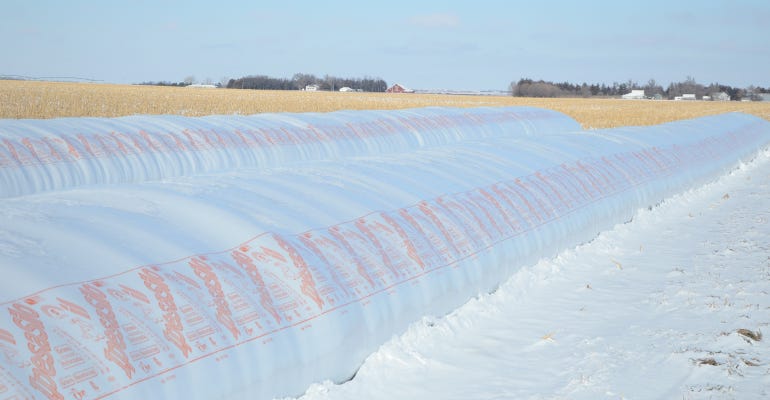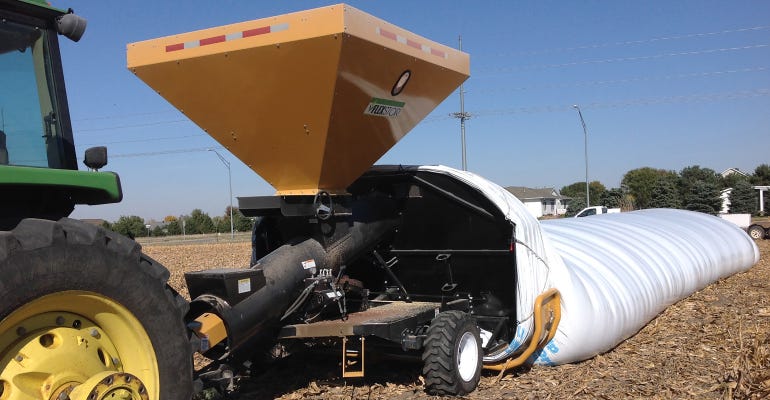
For Joel Bergman, using grain bags came out of necessity. About five years ago, he had some grain storage on land that he decided to let his son rent after he came back to the farm near Loomis, Neb.
"We had some hail that last year, and I wasn't expecting much of a crop, but it did better than I thought,” Bergman says. “We had no storage and no help to harvest, and I thought bags would take care of both of those problems. A lot of other people that have used bags have been in a situation that they needed to do something different in a hurry. It generally takes a catalyst to get someone to put bags out, because it's a change in thought process."
For the most part, however, that change has been a good thing, Bergman says. In addition to providing flexibility for short-term storage, it also has changed the way he harvests.
"Harvest labor is extremely hard to find, and good harvest help is even harder," he says. “Bagging just takes three guys — two hauling grain carts and one bagging. We would need one more guy, probably two, if we were hauling the grain off somewhere else. Some farms are unloading two or three combines into these bags, and they're moving fast. You would need two or three trucks to keep up with those combines, and you can do it with just one bagger."

HEAVY PLASTIC: Two 330-foot-long grain bags sit on Daren Englund's farm. Although different sizes are available, Englund typically opts for longer bags — and heavier plastic.

Todd Whitney, Nebraska Extension educator in Furnas, Gosper, Harland and Phelps counties, says that several growers in south-central Nebraska have realized this benefit.
"We've seen bag use increase quite a bit compared to five years ago," Whitney says. "It seems to be due to labor savings, and growers can be more timely about getting harvested grain in storage. There is an extra step this time of year for grain movement, but there have been advantages this year to storing the grain because the basis has been higher."
Bag placement matters
Those are some of the reasons Daren Englund started bagging grain 10 years ago on his farm near Holdrege. However, it does take a shift in mindset. One of the biggest differences between permanent storage structures is grain stored in bags tends to stay the same moisture going in and coming out.
"If the corn is wet, you can put it in a bin and dry it out,” Englund says. “With a bag, you can't do that. You put it in at 16% moisture, and it stays there. That's something you have to account for. For the most part, we've had luck. One year, I stored corn from harvest in early October to September the following year. We've never had anything go out of condition. We don't store very high moisture corn long term in bags — no higher than 16%."
With soybeans, Englund tries to have them delivered three months after harvest if they are stored in bags. And, bag placement is a big factor for both corn and soybeans — for accessibility and to prevent water from sitting in the bags.
"You want to keep them on high ground. You don't want to place them where you have water standing," Englund says. "I always set bags up so they're pointing toward the driveway, so it's easy to access when you're backing up the truck up toward the bag."
"You may get some small holes in the bags, but if you can keep the water from sitting in the bag, you can keep grain from going out of condition," Bergman says. "Before you unhook the bag, it's a good idea to place a board 5-to-10 feet into the pile to seal it off."
Englund and Bergman both have gone all in for grain bagging and have bought their own bagging and unloading equipment. However, loading a 400- to 500-pound bag on a bagger is job for at least two people — and it's often done with the help of a skid loader.
Rethinking grain marketing
While bags are available in different sizes, the most common are 300 feet long by 10 feet wide and hold about 14,000 bushels each. It typically costs anywhere from 8 to 12 cents per bushel to store corn in bags. For Bergman, having a less expensive storage option pays off when marketing his grain.

ACCOUNT FOR MOISTURE: A bag is loaded at harvest on Englund's farm near Holdrege. Storing grain in bags makes harvest more flexible, but Englund notes it's important to consider that corn stored in bags will be the same moisture coming out that it was going in.

Storing grain in bags has made him rethink his marketing strategies, because the grain typically isn't stored as long as it would be in permanent storage facilities. After switching to bags, he has mostly marketed his grain using basis contracts, giving him a chance to lock in basis (the difference between the cash and futures price) early on.
"First, I want to know I've got a place to go with the corn — and then I price it later,” Bergman says. “We're generally selling the basis first, and then coming back and selling the market. We try to sell this corn on the March futures — there's no holding it until August, because we want to farm that ground. If you market your grain right, oftentimes you're paying off that bag."
"Part of our marketing plan has always been to store the crop and take advantage of the carry into March or later. This is one way to do that," Englund says. "We figure it costs us about 12 cents per bushel — that includes the cost of the bag, filling the bag and emptying the bag. With the carry in the market, if you're trading on the December futures price, there's a positive carry to sell grain in March. We'll roll contracts to the March delivery period, and capture about 12 to 13 cents per bushel — and we're paying off the cost to store grain in the bag."
About the Author(s)
You May Also Like






